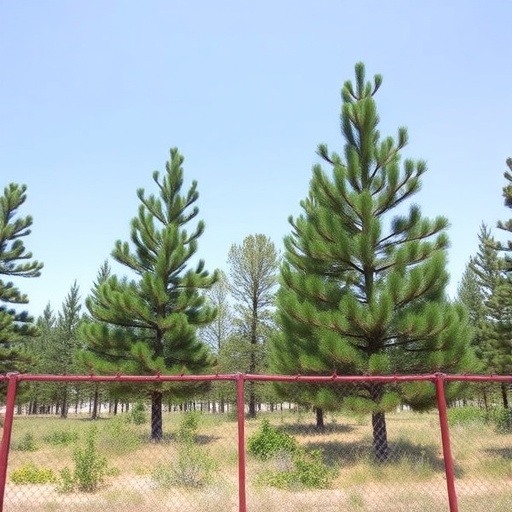In the heart of the Mediterranean region, a silent revolution is unfolding within the forests of Algeria. A recent study, conducted by researcher B. Nedjimi, delves deep into the characteristics of the Aleppo pine, scientifically known as Pinus halepensis. This conifer, known for its resilience and adaptability, plays a crucial ecological role by providing habitat and stabilizing soil in its native environment. Nedjimi’s research uncovers significant provenance variability in the physical attributes of Aleppo pine cones, seeds, and wings, highlighting the importance of local genetic diversity in forest management and conservation strategies.
The Mediterranean climate, characterized by hot, dry summers and mild, wet winters, presents unique challenges for tree species like the Aleppo pine. This study investigates how these environmental factors influence the morphological and reproductive traits of the species across different communities within Algeria. It sheds light on the adaptive strategies employed by the Aleppo pine, allowing it to thrive in such conditions while offering invaluable data for those interested in the genetics and ecology of forest ecosystems.
Through meticulous field studies, Nedjimi collected samples from various locations in Djelfa, Algeria, where the Aleppo pine is abundant. The cones, seeds, and wings were subjected to rigorous analysis, measuring attributes such as size, weight, and morphology. These detailed measurements reveal a biogeographical trend that suggests the influence of local climatic conditions and soil types on the development of these essential reproductive structures. The findings show that the trees from different locales exhibit significant variation, which has profound implications for forestry practices in the region.
The genetic diversity present in the Aleppo pine populations is not just an academic curiosity; it has direct relevance to the forestry industry. Understanding the provenance variability can aid in selecting the most suitable seed sources for reforestation and afforestation projects. Such information is critical, especially as climate change continues to impact forest ecosystems globally. By ensuring that reforestation efforts utilize seeds from local populations, forest managers can enhance resilience against pests, diseases, and changing climatic conditions.
Moreover, this research reminds us of the intrinsic connection between biodiversity and ecosystem services. The Aleppo pine serves as a keystone species, supporting a myriad of life forms, ranging from fauna that rely on this tree for shelter to flora that thrive in its shade. By studying the variations within its cones and seeds, we gain insights into how different populations interact with their specific environments, ultimately influencing the overall health of the ecosystem.
Nedjimi’s findings also contribute to the broader discussions around conservation strategies. As pressures from human activities, such as urbanization and agriculture, encroach upon natural habitats, preserving genetic diversity becomes paramount. The study advocates for informed policies that prioritize the conservation of existing Aleppo pine stands while also promoting the establishment of new populations using locally sourced seeds.
The research methodology employed by Nedjimi reflects best practices in ecological research, utilizing both field measurements and laboratory analyses. This holistic approach ensures robust findings that can withstand scrutiny while providing a framework for future studies. The study’s results have the potential to inform not only forestry practices in Algeria but also global discussions on pine conservation in other parts of the world.
Furthermore, the importance of disseminating these findings to stakeholders cannot be overstated. Engaging with local communities, policymakers, and conservationists is essential to ensure that the knowledge gained from this research translates into practical actions. As we face unprecedented environmental challenges, collaborative efforts at the intersection of science and community engagement could foster a renewed sense of stewardship for our natural resources.
In summary, B. Nedjimi’s exploration of the Aleppo pine reveals more than just the variability in cone, seed, and wing characteristics; it uncovers a story of resilience and adaptability in the face of environmental changes. The research underscores the vital role of genetic diversity in ensuring the survival of species within their native ecosystems. As we look to the future, investing in such studies will empower us to make informed decisions that reflect the complexities of our natural world, ensuring that species like the Aleppo pine continue to thrive for generations to come.
The study is a testament to the significance of local adaptations in species survival, acting as a reminder of the delicate balances present within ecosystems. It serves as a call to action for scientists, policymakers, and the public to recognize the value of our natural heritage. In the quest for sustainability, understanding the genetic makeup of our forests may hold the key to ensuring their health in an uncertain future.
In conclusion, while much work remains to be done regarding the conservation and management of Aleppo pines and other similar species, the findings from Nedjimi’s study offer a beacon of hope. By fostering a deeper appreciation for the intricacies of forest genetics and ecology, we can build a sustainable future that honors the resilience of nature, and is informed by science, stewardship, and community engagement.
Subject of Research: Provenance variability in cone, seed, and wing characteristics of Aleppo pine
Article Title: Provenance variability in cone, seed and wing characteristics of Aleppo pine (Pinus halepensis Mill.) from Djelfa, Algeria
Article References: Nedjimi, B. Provenance variability in cone, seed and wing characteristics of Aleppo pine (Pinus halepensis Mill.) from Djelfa, Algeria. Discov. For. 1, 7 (2025). https://doi.org/10.1007/s44415-025-00007-2
Image Credits: AI Generated
DOI:
Keywords: Aleppo pine, provenance variability, genetic diversity, conservation, forest management.




